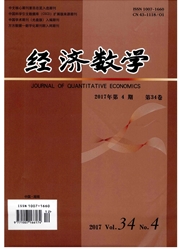

 中文摘要:
中文摘要:
在全球金融一体化程度不断深入的背景下,金融危机所伴随的传染效应需要加倍关注。以2007年全球金融危机为背景,采用多元FIAPARCH动态时变相关系数模型研究了此次危机对巴西、俄罗斯、印度、中国和南非五个新兴市场国家间的传染效应,按照宏观经济定性分析法和隐马尔科夫转换模型两种方式对金融危机演化过程的不同阶段进行了时间上的划分,并分别进行了实证研究。实证结果表明在金融危机爆发后的初期,均没有传染现象发生;随着危机的深入,各个市场开始受到美国市场的影响发生传染现象,但传染的时间窗口并不同步;随着雷曼破产事件的发生,传染程度加剧,五个市场同时受到强烈的传染;直到2009年随着全球经济的复苏,五个市场同时表现出强劲的回升势头,
 英文摘要:
英文摘要:
With the deepening of global economic and financial integration,we should place more attention on the contagion effect of global financial crisis. This paper empirically investigates the contagion effects of the global financial crisis in a multivariate Fractionally Integrated Asymmetric Power ARCH( FIAPARCH) dynamic conditional correlation( DCC) framework during the period 2001-2012. We focus on five most important emerging equity markets,namely Brazil,Russia,India,China and South Africa( BRICS),as well as USA during different phases of the crisis. The length and the phases of the crisis are identified based on both a qualitative and a quantitative approach. The empirical evidence does not confirm a contagion effect for most BRICS during the early stages of the crisis. As the crisis deepens,contagion effect appears but the infection time window is not synchronized. However,linkages reemerged after the Lehman Brothers collapse,suggesting a shift on investors' risk appetite. Moreover,correlations among all BRICS and USA increased from early2009 onwards,implying that their dependence is larger in bullish than in bearish markets. These findings could be attributed to their common trade and financial characteristics and provide to some extent.
 同期刊论文项目
同期刊论文项目
 同项目期刊论文
同项目期刊论文
 期刊信息
期刊信息
